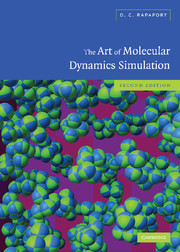Book contents
- Frontmatter
- Contents
- Preface to the first edition
- Preface to the second edition
- About the software
- 1 Introduction
- 2 Basic molecular dynamics
- 3 Simulating simple systems
- 4 Equilibrium properties of simple fluids
- 5 Dynamical properties of simple fluids
- 6 Alternative ensembles
- 7 Nonequilibrium dynamics
- 8 Rigid molecules
- 9 Flexible molecules
- 10 Geometrically constrained molecules
- 11 Internal coordinates
- 12 Many-body interactions
- 13 Long-range interactions
- 14 Step potentials
- 15 Time-dependent phenomena
- 16 Granular dynamics
- 17 Algorithms for supercomputers
- 18 More about software
- 19 The future
- Appendix
- References
- Function index
- Index
- Colophon
5 - Dynamical properties of simple fluids
Published online by Cambridge University Press: 28 February 2011
- Frontmatter
- Contents
- Preface to the first edition
- Preface to the second edition
- About the software
- 1 Introduction
- 2 Basic molecular dynamics
- 3 Simulating simple systems
- 4 Equilibrium properties of simple fluids
- 5 Dynamical properties of simple fluids
- 6 Alternative ensembles
- 7 Nonequilibrium dynamics
- 8 Rigid molecules
- 9 Flexible molecules
- 10 Geometrically constrained molecules
- 11 Internal coordinates
- 12 Many-body interactions
- 13 Long-range interactions
- 14 Step potentials
- 15 Time-dependent phenomena
- 16 Granular dynamics
- 17 Algorithms for supercomputers
- 18 More about software
- 19 The future
- Appendix
- References
- Function index
- Index
- Colophon
Summary
Introduction
In this chapter we encounter measurements of a type demonstrating some of the unique capabilities of MD. Because the complete trajectories are available, it is no more difficult to measure time-dependent properties, both in and out of equilibrium, than it is to measure thermodynamic and structural properties at equilibrium. Here we concentrate on properties defined in terms of time-dependent correlation functions at the atomic level – the dynamic structure factor and transport coefficients such as the shear viscosity are examples. Most of the analysis is incorporated into the simulation program, but it would of course be possible (though extremely storage intensive) to store the required trajectory data for subsequent processing.
Transport coefficients
Background
Transport coefficients describe the material properties of a fluid within the framework of continuum fluid dynamics. Discrete atoms play no role whatsoever in the continuum picture, but this does not seriously limit the enormous range of practical engineering applications of the continuum approach. The most familiar of the transport coefficients are those applicable to simple fluids; these are the diffusion coefficient, the shear and bulk viscosities and the thermal conductivity. Other transport coefficients appear when dealing with more complex fluids, such as those containing more than one species, or those with novel rheological behavior. In many problems the transport coefficients are assumed to be experimentally determined constants, depending only on the temperature and density of the fluid, which themselves are often assumed constant for a given problem, but in more complex situations transport coefficients can depend on local behavior, an example being the dependence of shear viscosity on the velocity gradient.
- Type
- Chapter
- Information
- The Art of Molecular Dynamics Simulation , pp. 120 - 152Publisher: Cambridge University PressPrint publication year: 2004
- 2
- Cited by



